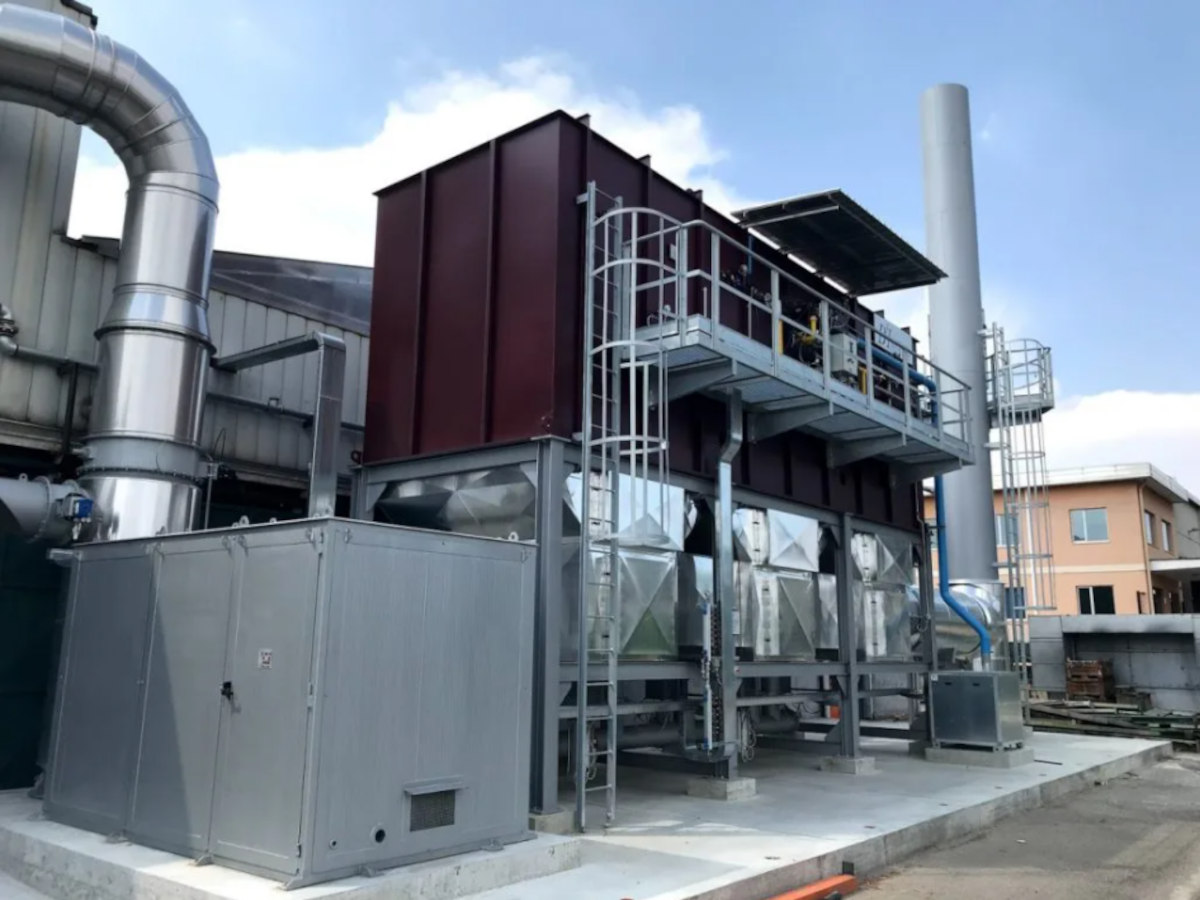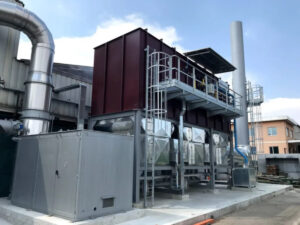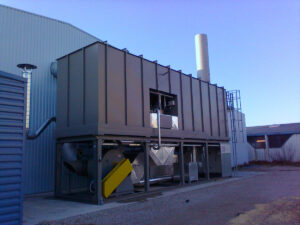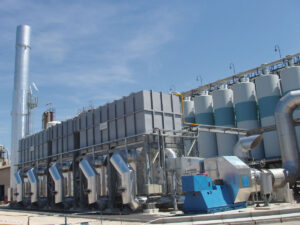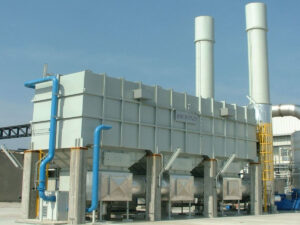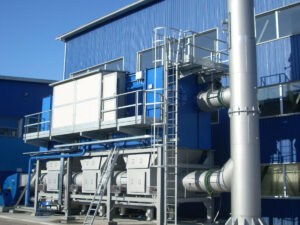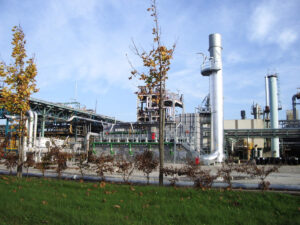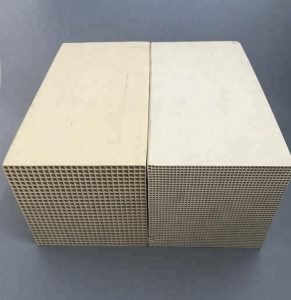- Regenerative thermal oxidizers: features and benefits
- Operating principle of regenerative thermal oxidizers
- Regenerative thermal oxidizers with pre/post treatment
- Electric thermal oxidizers – OxyTherm® eco2
- Typical applications and target sectors
- Customized plants solutions
- Go to the gallery with all our installations
Regenerative thermal oxidizers (RTOs) are highly efficient systems for the abatement of volatile organic compounds (VOCs), equipped with regenerative ceramic mass exchangers. These components provide exceptional heat recovery, reducing fuel consumption and ensuring efficiencies of up to 96%.
RTOs are designed according to each process’ specific needs and can be:
- 2-canister, with optional buffer tank
- 3-canister (or more, up to 7), ideal for managing higher air volumes.
This technology is particularly indicated both for emissions with low inlet VOC concentration (< 1 g/Nm³) – maximizing energy efficiency – and for emissions with higher concentrations, exploiting under these conditions the phenomenon of thermal self-sustenance, minimizing auxiliary fuel consumption and reducing operating costs.
Regenerative thermal oxidizers: features and benefits
- High purification efficiency: 98-99.8%
- High thermal efficiency: >96%
- Low production of secondary pollutants (CO, NOx)
- Possibility of additional energy recovery
- Suitable for applications with pollutant concentrations up to 25% of the LEL
- Modulating combustion to maintain the correct operating temperature at different pollutant loads and optimize energy consumption
- Low maintenance
- Combustion chamber lined with refractory materials and high-density ceramic fiber insulation to ensure greater system durability
- Low maintenance
- Remote control via PLC and remote assistance
Operating principle of regenerative thermal oxidizers
RTOs exploit a cyclic heat exchange process between several ceramic storage towers:
- Polluted air crosses the first tower, where the ceramic material that has accumulated heat transfers it to the inlet stream pre-heating it.
- The heated stream enters the combustion chamber, where the pollutants are oxidized at a controlled temperature.
- Clean air crosses the second tower, which absorbs heat before the effluent is released.
- A third tower enters purge mode, removing any residue to maintain the system’s efficiency.
Cyclic inversion valves ensure a continuous and efficient flow, always keeping one tower active and one tower in cleaning mode. Moreover, the technology developed by Brofind® makes it possible to optimize thermal consumption related to the variability of the organic pollutant load, significantly reducing the plant’s overall energy consumption.
Self-support and energy recovery
Thanks to its high thermal efficiency, a regenerative thermal oxidizer can reach autothermal operation, requiring no auxiliary fuel when VOC concentration is sufficient. This leads to significantly lower operating costs and improved environmental sustainability.
Regenerative thermal oxidizers with pre/post treatment
To handle complex pollutants and to ensure maximum plant efficiency, thermal oxidizers can be equipped with pre- and post-treatment systems.
✔ Pre-treatments
Pre-treatments are used to shield the oxidizer from pollutants that could jeopardize its functioning, e.g. silicon organic compounds, inorganic acids, inorganic bases, aerosol and dust. The solutions include:
- Cyclones
- Bag or cartridge filters
- Venturi and tower scrubbers
- Filtering panels
- Activated carbon adsorbers
- Filters for the removal of oily mists
✔ Post-treatments
Post-treatments are necessary when the effluent exiting the oxidizer needs further treatment to reduce specific undesired compounds, such as halogenated VOCs, sulphurates or siloxanes. Available technologies include:
- Quencher for rapid cooling
- Tower scrubbers, specifically designed for the abatement of acids and bases, ensuring pollutants neutralization before the final discharge
- Selective abatement systems to reduce specific emissions, including deNOx systems to reduce nitrogen oxides (NOx) produced during the oxidation process. DeNOx technologies include
- SCR (Selective Catalytic Reduction) with the injection of reagents such as ammonia or urea using catalytic support
- SNCR (Selective Non-Catalytic Reduction) with the injection of reagents such as ammonia or urea
Thanks to these integrations, Brofind® oxidizers ensure high performances and maximum reliability even with complex and variable flows.
Electric thermal oxidizers – OxyTherm® eco2
Brofind® offers fully electric solutions, cutting the use of fossil fuels and ensuring:
✔ Zero CO2 emissions from fuel
✔ High energy efficiency with heat recovery
✔ Compact dimensions and easy installation
✔ Reliability and reduced maintenance
Typical applications and target sectors
The main areas of application are:
- Chemical industry
- Pharmaceutical sector
- Painting and coating
- Printing and packaging
- Surfaces treatment
- Production of adhesives and solvents
- Waste industry and recycling
These systems are particularly effective in a variety of production environments, ensuring compliance with the most stringent environmental regulations and significant energy recovery.
Customized plants solutions
- 2-, 3-canister or multi-canister configurations
- Flameless operation
- Hot bypass to optimize heat recovery
- Special materials for corrosive gases or high temperatures
- Integrated heat recovery systems
- Low Nox emissions burners
